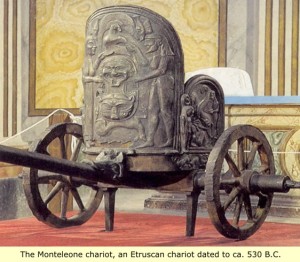Arthur Cottrell
Chariots
Chariots numbering ten thousand are mentioned as an important part of Atlantis’ armed forces. However, it is generally accepted that chariots first appeared in Mesopotamia around 3000 BC and became fairly commonplace by the middle of the second millennium BC. There is no evidence of any of the major Late Bronze Age nations having any more than a few hundred chariots. It would also appear that these chariots were normally reserved for nobles, wearing full bronze armour. War chariots were only effective over open and relatively flat ground.
 We should also keep in mind that the invention of the wheel itself is currently dated to not much earlier than 3500 BC(c) indicating that Plato’s reference to Atlantean chariots is anachronistic if we accept his apparent claim that the war with Atlantis took place around 9600 BC.
We should also keep in mind that the invention of the wheel itself is currently dated to not much earlier than 3500 BC(c) indicating that Plato’s reference to Atlantean chariots is anachronistic if we accept his apparent claim that the war with Atlantis took place around 9600 BC.
Regarding the Atlantis story, we must comment that 10,000 chariots controlled by one army, would only be required if a battleground had large tracts of flat land and if the enemy also possessed a similar force of chariots. Since no such enemy had been identified, we are forced to consider the clear possibility that the chariot numbers, as with so many other of the figures in Plato’s story, are suspect.
The greatest chariot battle in history took place in what is now Syria at the Battle of Kadesh in 1275 BC, between the Egyptians and the Hittites. The total number of chariots involved was between 5,000 and 6,000. In other words, a literal acceptance of what Plato wrote suggests that the Atlanteans had twice the number of chariots as that of the opponents at Kadesh combined, eight thousand years earlier! On top of that, those that accept the Atlantis story literally, try to tell us that the Atlanteans had 10,000 chariots, eight thousand years earlier than Kadesh, millennia before chariots were invented! As an aside, I should mention that the Battle of Kadesh was not the great victory by Ramses II that is often claimed(f).
The date given by Plato for the destruction of Atlantis is 9600 BC. This would make the existence of chariots at that time, not to mention in such numbers, a complete anachronism. It is not likely that Atlantis would have needed 10,000 chariots at any time without their enemies being similarly equipped, which is equally improbable at that early date and, of course, it required a battlefield suitable for such a clash. Plato’s date would appear to be out by about 8,000 years.
Since chariots were only introduced into Britain in the 5th century BC, in other words after Solon. This would seem to rule out Britain as the home or even a colony of the original empire of Atlantis. Similarly, with no evidence of chariots in the ancient Americas or the Caribbean, it would not be unreasonable to rule them out as the Atlantis of Plato. If the reference to chariots is to be taken as a real attribute of the Atlantean military machine, we are forced to look, in very general terms, to the Mediterranean region, both inside and outside the Strait of Gibraltar as far as the Black Sea and Egypt.
I must also add that from a functional point of view the most efficient chariots required spoked wheels and that the oldest examples of which have been dated no earlier than 2000 BC(a). This alone is a reason to question Plato’s Atlantis date.
Arthur Cottrell, in his Chariot[866], discusses how the chariot lost its dominance in battle but developed as a form of entertainment with the introduction of chariot racing and was frequently used in funerary rituals of several cultures. Chariot racing as a spectator sport in Rome dates back to around the 6th century BC. It was also quite popular among the Etruscans and the Lucanians of Sicily in the 5th century BC. It was recently revealed that Roman racing chariots had an additional iron tyre fitted to the right wheel greatly enhancing the charioteer’s chance of winning(e).
The close of the Bronze Age saw an end to the supremacy of the war chariot with the introduction of new weaponry and military tactics. Robert Drews is Professor of Classics and History at Vanderbilt University has claimed in his book, The End of the Bronze Age[865], that these changes were responsible for the collapse of so many eastern Mediterranean cities around 1200 BC. A review(b) of Drews’ book should also be read.
In conclusion, Plato’s reference to 10,000 chariots being employed in 9600 BC is either a colourful embellishment or a mangled account of the military power of an unnamed Bronze Age society. If the former, supporters of this early date for Atlantis must explain the total lack of archaeological evidence of chariots as early as 9600 BC as well as its continued absence during the succeeding six or seven thousand years.
>Plato’s numbers are obviously flawed and are matters that I deal with more comprehensively in Joining the Dots and the Dating Atlantis entry here.<
(a) Ron Wyatt and Those Egyptian Chariot Wheels – Dr. Michael Heiser (archive.org) *
(b) https://web.archive.org/web/20180704153826/https://alanlittle.org/weblog/chariots.html
(c) https://www.livescience.com/18808-invention-wheel.html
(e) https://www.seeker.com/secret-of-roman-race-chariots-found-2187581176.htm
(f) https://phys.org/news/2018-01-evidence-pharaoh-ramses-fake-news.html
